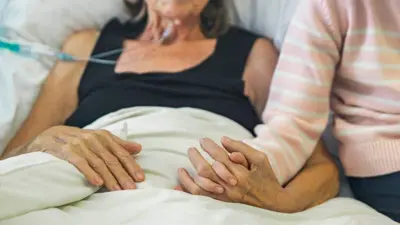We've updated our Privacy and Cookies Policy
We've made some important changes to our Privacy and Cookies Policy and we want you to know what this means for you and your data.
Farewell to arms as Inniskilling regiments march into history
Top Stories
- Author, Julian Fowler
- Role, ґуПуґ«ГЅ News
The regimental quick march Fare Thee Well Inniskilling had never been more appropriate.
The laying up of their last regimental standard on Sunday was the final official duty for the Old Comrades of the 5th Royal Inniskilling Dragoon Guards, known as The Skins.
Standards were once a rallying point on the battlefield, paraded before the troops so that all could recognise them.
They are consecrated before being taken into use and after service are laid up in sacred or public buildings.
Enniskillen is the only town to have its name carried by two British Army regiments, the Royal Inniskilling Fusiliers and the Royal Inniskilling Dragoon Guards.
Top Stories
Many former servicemen are still bitter that past defence cuts and amalgamations have resulted in the name Inniskilling disappearing from modern regiments.
Dressed in their scarlet coats, three Chelsea Pensioners had travelled to Enniskillen for the ceremony, including Sam Cameron who served with the regiment for three years.
He was wounded in Aden in 1965 and became emotional as his thoughts turned to those he had served alongside and those who had lost their lives.
Top Stories
"Very sad," he said. "A good regiment consigned to history, the best regiment in the British Army."
The Royal Dragoon Guards, who had recently returned from Afghanistan, joined the veterans as the standard was brought to St Macartin's Cathedral.
Enniskillen remains their spiritual home and their cap badge bears the insignia of the Watergate of Enniskillen Castle.
Their commanding officer, Lt Col Tom Bateman, said it was an emotional day but he added that it was not the end of the Inniskillings.
"It's the continuation of their legacy to us as they pass it on to us and we the Royal Dragoon Guards will carry that on," he said.
"We're very, very proud of the history that they have which stretches back 300 years."
The regiment was raised to defend Enniskillen from the forces of Catholic King James II.
It fought alongside King William at the Battle of the Boyne in 1690.
Their standard recalls battle honours including Waterloo, Sevastapol, Balaklava and the Korean War 1951-52.
"It (the standard) represents the passion and honour of a regiment," said Col Bateman.
"It is the history that we carry with us and the pride that we have in our everyday activities."
Those values are exemplified by one of the regiment's most famous soldiers, Capt Lawrence Oates, who walked to his death during Capt Scott's ill-fated Antarctic expedition.
His last words, "I am just going outside, I may be some time", are an understatement of courage and bravery.
He served when the Royal Inniskilling Dragoons were a cavalry regiment.
In 1938 a standard was laid up in a ceremony as it moved from horses to a mechanised brigade of light tanks.
In a Pathe News recording of the event the commentator says: "The cavalry standard will remind them of their glorious past, of the wild charges in the days before modern warfare."
They no longer charge into battle on horseback.
In their latest deployment the Royal Dragoon Guards were training the local police force in Afghanistan.
They have now returned to Catterick Garrison in North Yorkshire where they are preparing to move from tanks towards becoming a reconnaissance force.
The colonel of the regiment, Brig Johnny Torrens-Spence, said the loss of the Inniskilling name is a sign of changing times.
"The world moves on and the Royal Dragoon Guards now represents Enniskillen to the Army," he said.
Brig Torrrens-Spence presented the standard to the Dean of St Macartin's Cathedral where it will be displayed in the regimental chapel.
Top Stories
More to explore
Most read
Content is not available








